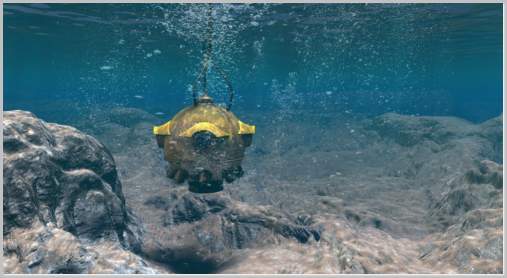
A Bathysphere is a spherical, armored and watertight container meant to enclose one or more human observers, or in some cases, camera equipment. It is used to investigate under water environments at great depth. It is lowered and retrieved by cable from a surface support ship. A bathysphere is incapable of independent movement, cannot support divers and should the supporting cable part cannot surface on its own and will invariably be lost with any crew that may be on board at the time.
Bridging a gap:
Due to their obvious limitations as research vessels bathyspheres were in vogue for a very brief period of time only. Diving bells, scuba gear and surface supplied diving suits all allowed for varying degrees of underwater work and observation to be done, but were confined to more or less shallow waters. Military submarines do not make good undersea observation platforms and until very recently, were also limited to shallow waters. The Bathyscaphe and deep submersible diving suit had yet to be invented.
In the early years of the 20th century, if man wished to personally observe the undersea world below a depth of 1000 feet, he would have to invent a special device to so. In 1928 Otis Barton would do just that. It would become famous as the Bathysphere – from the Greek “bathos” for depth and “sphaira” for sphere.
The catalyst which caused Barton to design and construct the first bathysphere came in the form of Charles William Beebe, naturalist, explorer and underwater pioneer. Beebe, much like Baton aspired to explore the ocean at depths that man had heretofore been unable to reach. Late in the 1920’ he designed and speculated about a self contained cylinder with ¼” armored walls and a window, in which the explorer just had room to stand. Barton heard of the design and realized that the vehicle was a death trap, the cylindrical design was not inherently a robust one and ¼” steel, no matter how strong would crush like an eggshell at a relatively shallow depth.
A partnership evolves:
Barton had a design he believed would work, but initially had trouble communicating the details of it to Beebe, who was skeptical of the various crackpot ideas and blueprints he was receiving unsolicited from a well meaning but uniformed public. A mutual friend however was able to arrange a meeting in 1928 and Beebe immediately saw the advantages to Barton’s simple, but strong design.
The two arranged to build the bathysphere and share the expenses of a mutual expedition to break undersea dive records and explore the unknown depths first hand. Barton would fund the construction of the bathysphere, while Beebe would obtain the ships and operating funds required.
Underwater wrecking ball:
The bathysphere Barton delivered was a simple sphere weighing nearly 6 tons empty, composed of nickel steel one and one half inches thick. Two windows formed from quartz 3 inches thick allowed a view of the outside world for one of the crew, and for a spotlight to be trained through the other.
A steel cable 7/8 of an inch thick supported the craft while two pairs of wires supplied the electricity for the spotlight and telephone communication to the surface.
Breathable atmosphere was maintained by utilizing two on board oxygen tanks to rejuvenate the air. Racks of pans containing soda lime extracted the excess carbon dioxide, similar racks of Calcium chloride absorbed moisture. The flow of air to be treated was maintained by waving two hand held palm fans in the general direction of the racks.
The interior of the sphere was incredibly cramped and uncomfortable, with a diameter of barely 4’ 9”, and with an unpadded interior surface of chilled metal. Dives of over 3 hours were said to be unendurable.
Unparalleled depths:
The two pioneers were able to achieve their primary goal – to shatter depth records – in short order, going first to 600 feet, and then progressively deeper until on August 15th, 1934 they would reach 3028 feet, the deepest that the original bathysphere would ever reach.
Beebe and Barton would discover numerous bizarre deep sea fauna and flora, only to be ridiculed by the self styled mainstream scientists of their day who questioned both their veracity and methods. They also did not like the medium Barton and Beebe chose to present their finds, writing popular books for the public in general as opposed to dry peer reviewed journals. Time and further exploration have vindicated all of their claims, however.
The original bathysphere was for a time, literally, consigned to a scrap heap, it has been recovered and now may be seen outside the New York Aquarium.
Barton goes on:
Beebe and Barton went their separate ways shortly after setting the world’s record for depth achieved by a human being who lived to tell the story. Barton would write the final chapter in bathysphere lore when he created an improved model which he called a “Benthoscope” in 1949. Barton in his benthoscope would set what would the acknowledged deep dive record of 4500 feet.
Barton’s benthoscope was essentially the end of the line for the manned bathysphere although unmanned versions are still used to immerse cameras and arrays of scientific instruments to great depth. Bathyscaphes like the Trieste and specially built deep water submersibles like Woods Holes’ famous Alvin are much safer, more versatile and replaced bathyspheres in the early 1960’s. Trieste would establish an undersea depth record that in all likelihood will never be exceeded, diving to over 35,000 feet in the deepest spot on earth, the Mariana’s trench.
Although the scientific value of the manned bathysphere proved to be limited their missions broke depth barriers that had been held to be impassable. The courage of the very few souls who plunged miles beneath the oceans surface in an iron ball dangling from a string can never be overstated.

